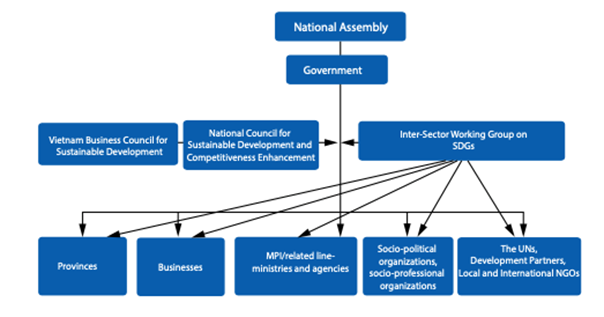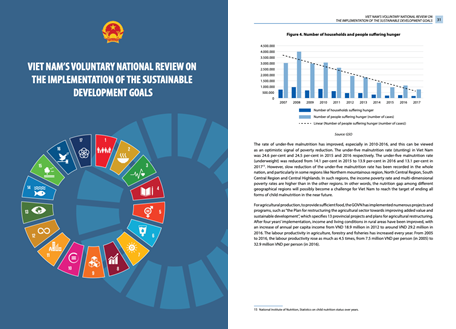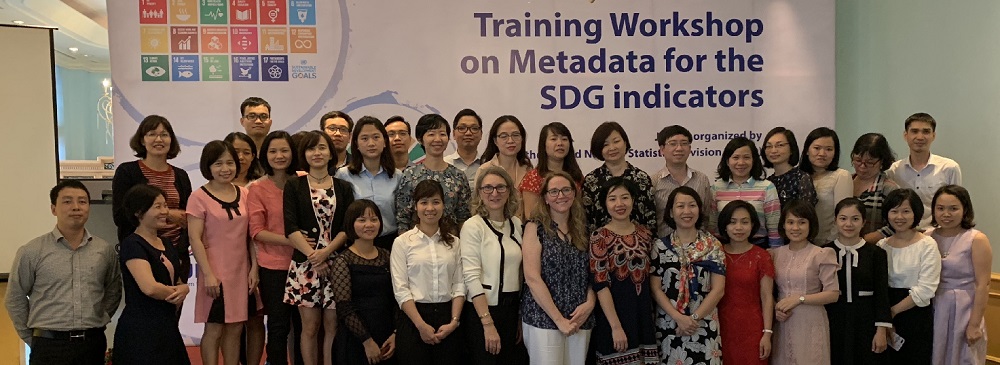Viet Nam
I. General on SDG monitoring set up
National SDG organizational set up
The arrangements and responsibilities for the implementation of the 2030 Sustainable Development Agenda were set out in a National Action Plan (NAP), published in 2017 (Decision No. 622/QĐ-TTg). The National Council on Sustainable Development and Competitiveness Enhancement, issued by the Prime Minister under Decision No. 419 / QD-TTg in 2018, is an advisory organization for the Government, Prime Minister on issues related to Sustainable development and competitiveness.
The Ministry of Planning and Investment (MPI) is the lead agency for implementing the 2030 Agenda and the NAP. The Planning-Finance Departments of other ministries and related agencies and provincial Departments of Planning and Investment (DPI) are focal agencies to implement the 2030 Agenda. Some ministries, related agencies and provinces have also established steering committees, sustainable development offices or/and supporting units on sustainable development.
The institutional arrangements for SDG implementation in Viet Nam are summarised in the diagram below:

National set of SDG indicators
Vietnam has developed and issued a set of sustainable development statistical indicators of Vietnam according to Circular No. 03/2019 /TT-BKHDT dated January 22nd, 2019 of the Minister of Planning and Investment, including 158 indicators.
The set of indicators is based on two main principles: (1) To ensure the reflection and evaluation of 17 goals and 115 targets of Viet Nam (corresponding to 17 global goals and 145 global targets); (2) To ensure international compatibility and comparability but still meets practical conditions as well as needs of sustainable development of Vietnam; (3) To ensure feasibility and consistency with other statistical indicators systems of Vietnam.
To develop the indicators, the GSO established an Editorial Team. During 2017 and 2018, the GSO evaluated the feasibility, availability and applicability of the global indicators, and assessed the comparability of the selected indicators and the corresponding global SDGs and VSDGs. The GSO also organised a wide consultation with experts, ministries, government agencies, international organisations, NGOs and local authorities through a series of consultative workshops, as well as through the E-Portal of the MPI and GSO. Of the 158 VSDG indicators, 140 were planned for implementation from 2019, with the remainder due for implementation from 2025. In addition, 112 of Viet Nam’s statistical indicators are similar to 101 of the global SDG indicators.
SDG reports and Voluntary National Reviews
Viet Nam presented its VNR to the UN High Level Political Forum in 2018.
Under the Statistical Action Plan for SDGs, the GSO intends to develop a schedule for disseminating statistical information on the Sustainable Development Statistical indicators through dashboards on a website; the compilation of statistical publications; and other methods such as leaflets, the media, seminars and press conferences.

The platform is currently under development. GSO have chosen to develop an SDG platform based on PxWeb, which they already use as a statistical bank for their general statistics dissemination.
GSO are currently using an older version of PxWeb for disseminating indicators covering various statistical domains including SDG Indicators. GSO have also developed a web-based in-house data collection application for some indicators that are coming from line ministries, using an Excel template.
As part of the UNSD-FCDO Project on SDG Monitoring, UNSD organised, in collaboration with Statistics Sweden, a 4-day technical workshop on the use of the PxWeb data dissemination platform in Sweden where Vietnam participated. In various demonstrations, discussions, and hands-on exercises, participants covered topics such as the mapping of the SDMX and PxWeb information models, how to leverage the PxWeb Application Programming Interface, how to customize PxWeb user interface to national needs and how to better integrate PxWeb with web GIS dissemination tools.
Viet Nam will be working on creating a section on SDGs in their existing PxWeb dissemination platform following the training provided. The project is planning to facilitate its implementation jointly with Istat, who are also supporting GSO as part of a broader strategic collaboration.
Overall coordination of National Statistical System
In Viet Nam, the structure of the National Statistical System is set out in the 2015 Statistical Law. The General Statistics Office (GSO) operates directly under the Ministry of Planning and Investment (MPI), acting as an adviser to the MPI Minister in the management of official statistics; conducting statistical collection and production activities; and providing social and economic information to organizations and individuals domestically and internationally in accordance with the law. GSO is structured vertically from the national to the local level: In addition to the national office, there are 63 provincial statistical offices and several hundred district level statistical offices. More information can be found on their website
As well as the GSO, line ministries and the Ministerial-level agencies also form part of the Vietnamese Statistical System and are responsible for the production of official statistics relating to their designated areas of authority.
Viet Nam has a 10-year National Strategy for Development of Statistics (NSDS) which is valid for 2011 to 2020. Since it was developed before the SDGs were negotiated, there is no direct link to SDG implementation.
SDG data coordination committees
The MPI (GSO) has established a Statistical Working Group for monitoring and supervising the implementation of the sustainable development goals. In addition to representatives of MPI, the membership also includes representatives of concerned ministries and other organisations with responsibility for the implementation of specific VSDG targets.
The working group has developed and is implementing a Statistical Action Plan for monitoring the implementation of sustainable development goals (Decision No.1038/ QĐ-BKHĐT). Other responsibilities of the working group include:
- Identifying appropriate data and data gaps relating to the implementation of the VSDGs;
- Identifying difficulties and challenges relating to monitoring and supervising the implementation of the VSDGs, and proposing appropriate solutions;
- Guiding ministries, ministerial-level agencies and other relevant organisations in the development of statistical indicators relating to their responsibilities under the NAP.
Responsibility for SDG indicator compilation
Responsibilities for data collection and compilation for the SDGs are set out in the 2019 Set of Sustainable Development Statistical Indicators for Vietnam publication (Circular No.03/2019/TT-BKHĐT). In which, GSO is responsible for collecting 62 indicators; 21 other ministries and agency are responsible for collecting 96 indicators.
Circular 03/2019/TT-BKHDT regulates: The Ministry of Planning and Investment (General Statistics Office) shall take the lead, in coordination with relevant agencies to collect and synthesize targets. Ministries and branches responsible for collecting and aggregating the assigned indicators, then reporting them to the Ministry of Planning and Investment (the General Statistics Office) for consolidation and compilation.
A 2015 Decision by the Minister of Planning and Investment sets out the scope and mechanisms for coordinating the sharing of data between the GSO and statistics departments within ministries (No. 1471/QĐ-BKHĐT). This decision contains information on what types of information can and cannot be shared, the development of a statistical information list to support sharing, the identification of focal points, and the development of knowledge, methods and systems.
When SDG data needs to be synthesized: GSO sends an Official Dispatch to ministries and agencies to request them to provide data.
IV. Data availability and disaggregation
Work to make more indicators available
In order to have more SDG data, the General Statistics Office is working to integrate the module to collect some more SDG indicators into surveys in the National Statistical Survey Program.
In addition, some SDG indicators are also actively being collected through some surveys outside the National Statistical Survey Program supported by international organizations: including a survey on violence against women and girls (finished) and time use survey.
The General Statistics Office is also working to increase availability of SDG data through the exploitation of administrative data, including tax data, customs data and education data.
Work to allow more data disaggregation
Currently 22 indicators have data allowing at least one form of disaggregation. The Annex to the published list sustainable development statistical indicators sets out which disaggregations should be possible and relevant for each indicator, and work to progress this is being carried out under the Statistical Action Plan.
Metadata of each SDG indicator of Vietnam is developed in 5 parts: (1) Definition, calculation method; (2) Main disaggregation; (3) Release period; (4) Data sources; (5) The organization in charge of collecting and aggregating data.
These contents are released alongside the list of VSDG Indicators according to Circular No. 03/2019 / TT-BKHDT.
The contents of this metadata are based on global metadata research, however, it is also considered important to be consistent with the current set of statistical indicators as well as in accordance with the laws in Vietnam, in accordance with the reality of Vietnam.
Under the Statistical Action Plan, the GSO plans to deliver training on Viet Nam's Sustainable Development Statistics Indicators to help organisations producing data for the indicators raise their awareness and skills. Such training will cover national ministries, provinces and districts.



